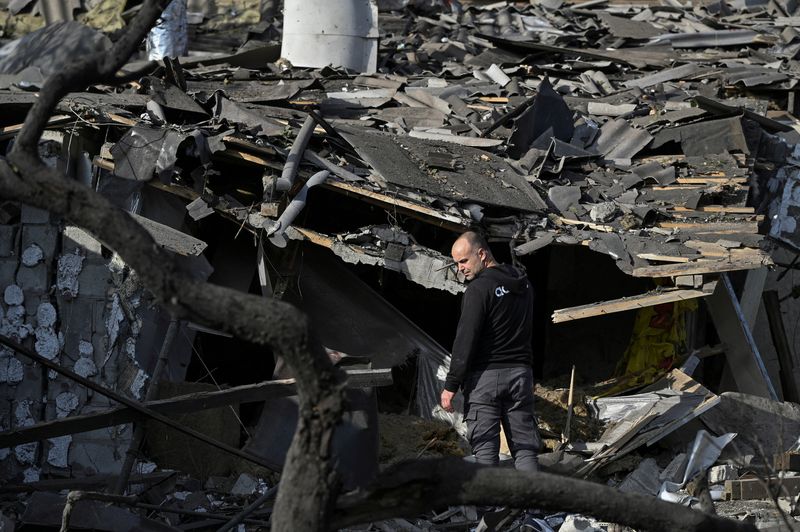By Olena Harmash
KYIV (Reuters) – Russia’s full-scale invasion of Ukraine reaches its 1,000th day on Tuesday, a grim milestone in Europe’s deadliest conflict since World War Two.
Devastating human and material losses continue to mount, leaving Ukraine more vulnerable than at any time since the early days of the war. Following is a summary of Ukraine’s losses since the invasion.
HUMAN TOLL
As of Aug. 31, 2024 the UN Human Rights Monitoring Mission in Ukraine had documented at least 11,743 civilians killed and 24,614 wounded in Ukraine since the start of Russia’s full-scale invasion.
UN and Ukrainian officials say the actual figures are probably much higher, given the difficulty in verifying deaths and injuries, especially in areas such as the devastated port city of Mariupol that are now in Russian hands.
Ukrainian prosecutors said 589 Ukrainian children had been killed by Nov. 14, 2024.
Though civilians have suffered greatly, the vast majority of the dead are soldiers: a rare all-out conventional war fought by two comparably equipped modern armies has been extraordinarily bloody. Many thousands have perished in intense fighting across heavily fortified front lines under relentless artillery fire, with tanks, armoured vehicles and infantry mounting assaults on trenches.
Both sides closely guard tallies of their own military losses as national security secrets, and public estimates by Western countries based on intelligence reports vary widely. But most estimate hundreds of thousands of wounded and dead on each side.
Western countries believe Russia has suffered far worse casualties than Ukraine, sometimes losing more than 1,000 soldiers killed per day during periods of intense fighting in the east. But it is Ukraine, with around a third of Russia’s population, that is likely to be facing the more severe manpower shortages arising from battles of attrition.
In a rare Ukrainian reference to its military death toll, President Volodymyr Zelenskiy said in February, 2024 that 31,000 Ukrainian service members had been killed. He gave no figures on the number of injured or missing.
Apart from the direct casualties, the war has raised mortality rates from all causes across Ukraine, caused the birth rate to collapse by about a third, sent more than 6 million Ukrainians fleeing abroad to Europe and displaced nearly 4 million inside the country. The United Nations estimated that Ukraine’s population had declined by 10 million, or around a quarter, since the start of the invasion.
TERRITORY
Russia now occupies and claims to have annexed around a fifth of Ukraine, an area around the size of Greece.
Moscow’s forces initially stormed through northern, eastern and southern Ukraine in early 2022, reaching the outskirts of Kyiv in the north and crossing the Dnipro River in the south. Ukraine’s military pushed them back throughout the first year of the war, but Russia has still kept swathes of southern and eastern territory, added to land it and its proxies had already seized in 2014. Moscow has now captured nearly the whole of the Donbas region in Ukraine’s east, and the entire coast of the Sea of Azov in the south.
Many cities in the frontline area that have been captured by Moscow have been destroyed, largest among them the Azov port of Mariupol, with a population before the war of around half a million. In the past year, Russia has slowly extended its grip in intense fighting, mainly in the Donbas. Ukraine, for its part, launched its first large-scale assault on Russian territory in August and has captured a sliver of western Russia’s Kursk region.
DEVASTATED ECONOMY
Ukraine’s economy shrank by about a third in 2022. Despite growth in 2023 and so far this year, it is still only 78% of its size before the invasion, First Deputy Prime Minister Yulia Svyrydenko told Reuters.
The latest available assessment by the World Bank, European Commission, United Nations and Ukrainian government found that direct war damage in Ukraine had reached $152 billion as of December, 2023, with housing, transport, commerce and industry, energy and agriculture the worst-affected sectors.
The total cost of reconstruction and recovery was estimated by the World Bank and Ukrainian government at $486 billion as of the end of December last year. The figure is 2.8 times higher than Ukraine’s nominal gross domestic product in 2023, according to economy ministry data.
Ukraine’s power sector has been particularly hard hit, with Russia regularly targeting infrastructure in long range attacks.
Ukraine is one of the world’s main sources of grain, and the interruption of its exports early in the war worsened a global food crisis. Exports have since largely recovered with Ukraine finding ways to circumvent a de facto Russian blockade.
Ukraine spends most state revenues funding defence, and relies on financial aid from Western partners to pay pensions, public sector wages and other social spending. Each day’s fighting costs Kyiv about $140 million, said Roksolana Pidlasa, the head of parliament’s budget committee.
The draft 2025 budget envisages that about 26% of Ukraine’s GDP, or 2.2 trillion hryvnias ($53.3 billion), would go on defence. Ukraine has already received more than $100 billion from its Western partners in financial aid.

